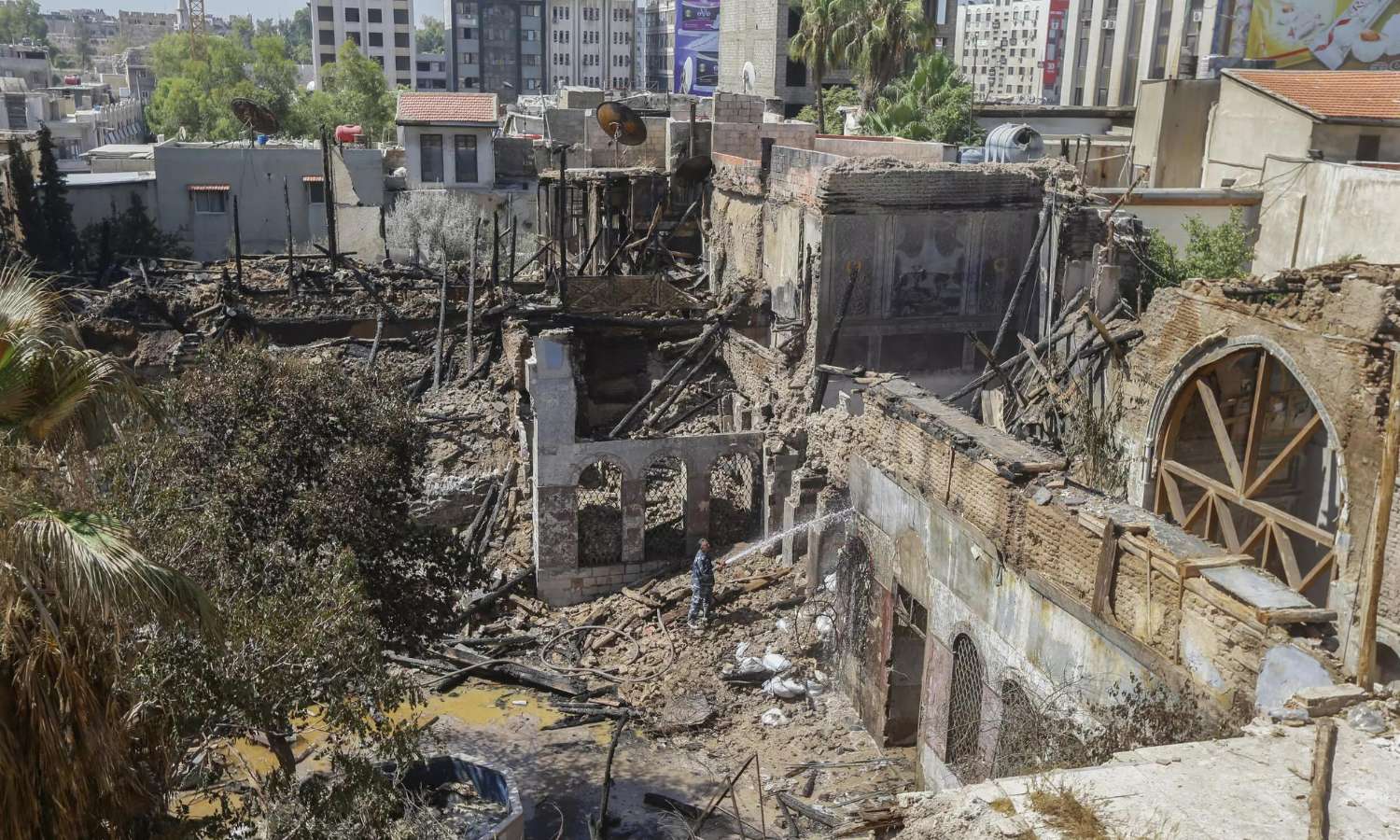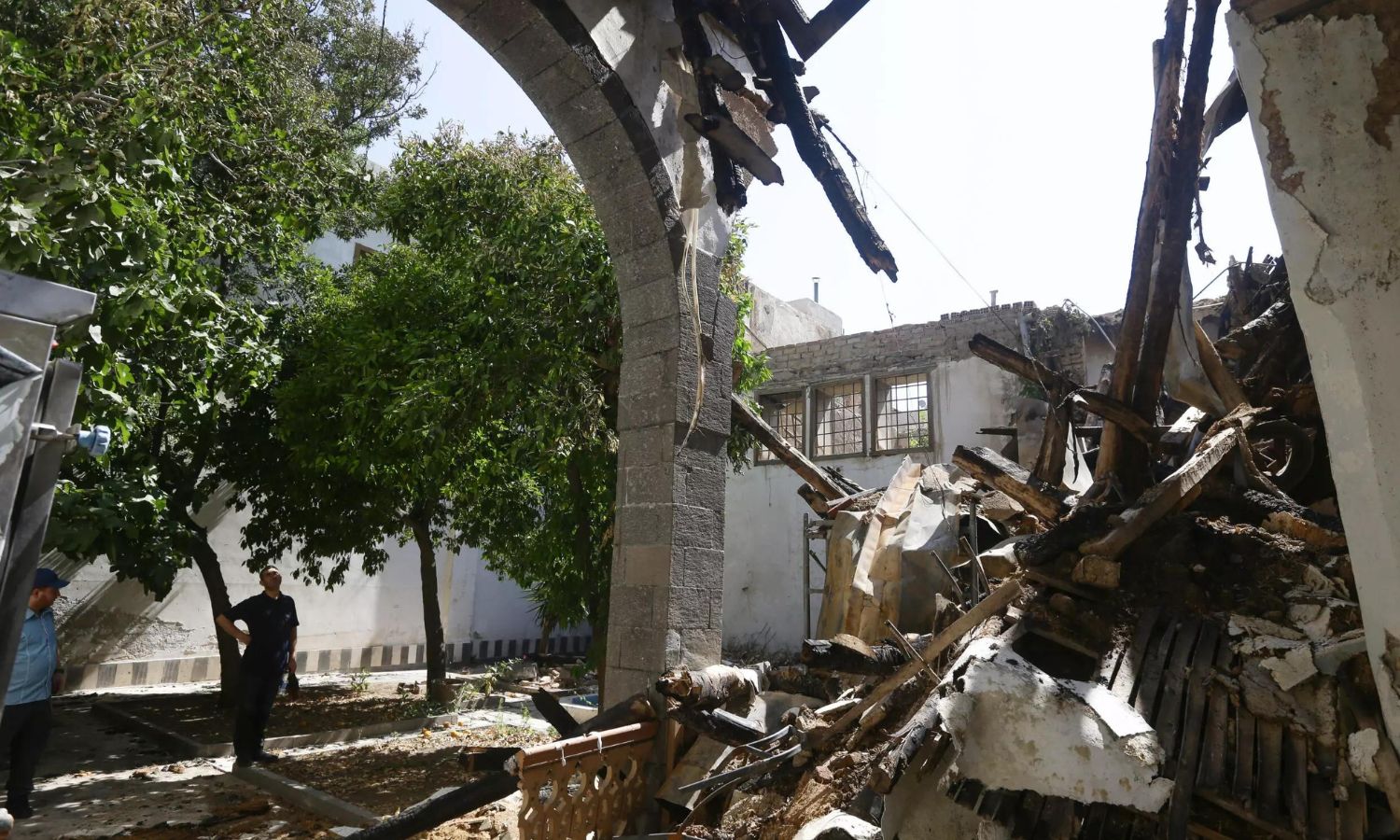



Enab Baladi – Yamen Moghrabi
On the night of July 16, a fire broke out in the 800-year-old Souk Sarouja of Damascus, causing a vast amount of damage to historical landmarks and homes that witnessed the heritage of more than 200 years.
The fire centered in al-Thawra Street in the Syrian capital’s Sarouja market, in a house adjacent to the palace of Emir Abd al-Rahman Pasha al-Youssef, who led Syrian pilgrims on the Hajj pilgrimage in the late 19th and early 20th centuries.
The fire also spread to dozens of historic homes and shops in the area, causing mass damage to the entire old Damascene district.
Images and videos shared by activists online and state-run media showed the fires ravaging Sarouja market.
In addition to the house of the Damascene Emir al-Hajj, fire affected part of the al-Azm house, one of the most prominent Damascene ruling families that played a pivotal role in Syrian political life in the twentieth century, in the period that preceded the Baath Party’s accession to power in Syria in 1963, according to the statements of the Director General of Antiquities and Museums, Nazeer Awad, to the local al-Khabar TV, on July 16.

The walls of the house of the al-Azm family in Damascus, a family that played an important political role in Syria – July 18, 2023 (AFP)
So far, no statement has been issued by the government of the Syrian regime on the extent of the damage, the number of damaged homes and shops, or the causes of the fire.
Al-Youssef and al-Azm houses adjoined each other and were originally owned by a person named Suleiman Kilar Amini and rented by the Prussian (now German) Consulate in 1849.
Photos published by the AFP showed rubble in al-Azm’s house and the fall of entire walls, while the palace of Emir Abd al-Rahman Pasha al-Youssef was almost destroyed.
In 2016, fires devoured a large part of the al-Asrounieh market, and another fire broke out in the al-Hamidiyah antique market in 2022.
Historian Saad Fansa told Enab Baladi that the documents in the “Directorate of Historical Documents” constitute the “historical stock of Damascus,” with manuscripts, old books, photographs, Ottoman personal status records, and the genealogical trees of Damascene families.
It is not certain, until the moment of writing this report, that losses were recorded in the historical documents, according to Fansa, as part of the important documents and antiquities were transferred in 2012.
Fansa previously held the position of Director of Photography, Archaeological Archive and Documentation at the Damascus Museum.
Among the documents contained in the museum are the correspondences of the governor of Damascus, Midhat Pasha, to Sultan Abdul Hamid II, containing an explanation of the political situation in the Levant, and details of the contacts of the governments of France, Britain, and the United States of America with several Syrian sects, according to Fansa.
It is not yet known whether the documents were among those transferred in 2012 or not.
In a study prepared by the researcher on the history of Damascus, Imad al-Armshi, the Damascus Historical Museum is divided into several halls, in which old Damascene furniture (mosaic, seashells inlaid with silver, and brocade tablecloths) are displayed.
As for the documents, they include pictures of Arab kings and presidents, pictures of Syria in different eras, and more than five million documents and manuscripts, some of which date back 500 years.
It also contains a collection of Sharia court records for Damascus, Aleppo, Hama, and Homs, numbering 2,500 records.
Each record includes 300 rare documents, a record of the Palestinian city of Gaza, a set of royal orders in the Turkish language, translated Turkish books, records of commercial courts, and issues of the Official Gazette in the Ottoman Empire, giving a complete picture of the shape of society 100 years ago.
In addition to all of the above, according to al-Armshi, there is a section that contains a collection of papers, letters, and personal notes of politicians and social and national figures who played a role in the Syrian national movement, as well as other papers related to political parties in Syria and some Arab countries between 1910 and 1950.
It also includes issues of the Syrian Official Gazette from 1919 until today and records of mixed courts.
There is a small historical library containing important books on the contemporary history of Syria, in the areas of politics, society, and economics, in several languages.
Sarouja is known among the Damascene as Little Istanbul, given that it was a neighborhood inhabited by political figures and ambassadors from the beginning of the twentieth century until the fifties.
Al-Azm Palace was inherited by the former Syrian Prime Minister, Khaled al-Azm (1903-1965), and through it, he managed the Syrian government before its ownership was transferred to the Syrian government with the nationalization decisions after 1963, then its ownership was transferred to the General Directorate of Antiquities and Museums in 1969, and it was previously listed as a historical landmark in 1960.
Later, according to al-Armshi, the palace was known as the “Damascus Historical Museum,” and it contained a center for historical documents and a museum for Damascene arts and crafts.
The palace has a three-winged hall with a north room decorated “exceptionally.”
The huge palace, while being a Prussian consulate, also contained offices for the consulate, a section for servants, stables for animals, a large kitchen and bathroom, while its roof overlooked Mount Qasioun surrounding Damascus.
The house of Mohammad Fawzi Pasha, the son of Ali Pasha al-Azm, is one of the oldest houses in the Sarouja area, with an area of more than three thousand square meters, and was built at the end of the 18th and early 19th centuries, according to the researcher in the history of the city of Damascus.
Before the house was bought by the al-Azm family, it was owned by one of the dignitaries of the Ottoman Military Chancellery, Suleiman Kilar Amini, and contained inscriptions dating back to 1877.
The heir, Khaled al-Azm, assumed the presidency of the Syrian government six times, the first for a few months in 1941 and the last in March 1963, and he was the last prime minister of Syria before the Baath coup that year.
He also assumed the presidency of Syria temporarily in 1941 and the Ministry of Defense twice, in 1945 and 1955.
Al-Azm died in Beirut in 1965.
The study, which was reviewed by Enab Baladi, and prepared by al-Armshi, refers to a door that connects the homes of al-Azm and al-Youssef.
Before the fire, al-Youssef’s house was shared by 35 families, while some parts of it were allocated as a center for small commercial businesses, and it was in poor condition and in need of restoration.
Emir Abd al-Rahman Pasha al-Youssef is considered one of the most prominent Damascene personalities. He led Syrian pilgrims on the Hajj pilgrimage in the late 19th and early 20th centuries and was a member of the Ottoman Senate.
Historian Sami M. Moubayed said in an article published by the Saudi magazine Al-Majalla on July 17 that al-Youssef did not support the Great Arab Revolt. After the fall of the Ottoman Empire, he founded a political party called the Syrian National Party.
He was elected to the Syrian National Congress (the first parliament in Syria’s modern history) and was vice-president to Hashem al-Atassi; then, he was appointed president of the Shura Council in 1920.
According to Moubayed, al-Youssef proclaimed himself leader of Damascus, opening the doors of his palace to the poor and needy before his assassination in 1920.
if you think the article contain wrong information or you have additional details Send Correction